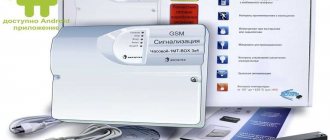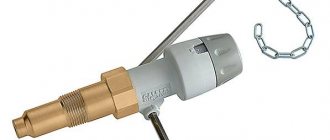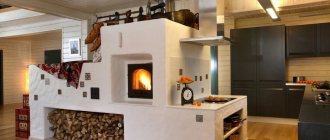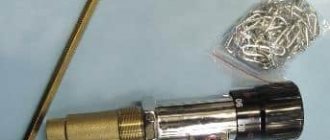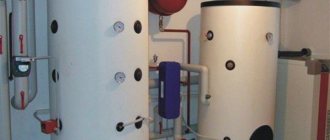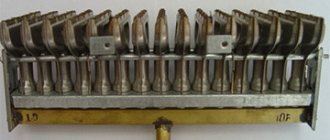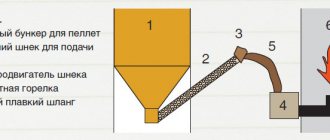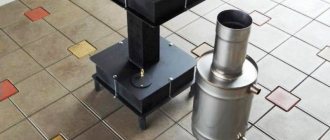The boiler design provides for the presence of several control elements that control the outlet temperature of the coolant. A thermostat is a device that responds to changes in temperature. Often, in old or budget models of heating boilers, primitive types of this element are installed. They can only activate or deactivate the heating function. Therefore, in order to optimize the operation of the system, homeowners are thinking about how to make a temperature controller for the boiler with their own hands.
Purpose of thermostats
Any electric or gas boiler is equipped with an automation kit that monitors the heating of the coolant at the outlet of the unit and turns off the main burner when the set temperature is reached. Solid fuel boilers are also equipped with similar means. They allow you to maintain the water temperature within certain limits, but nothing more.
In this case, the climatic conditions indoors or outdoors are not taken into account. This is not very convenient; the homeowner has to constantly select the appropriate operating mode for the boiler on his own. The weather can change during the day, then the rooms become hot or cool. It would be much more convenient if the boiler automation was oriented towards the air temperature in the rooms.
To control the operation of boilers depending on the actual temperature, various heating thermostats are used. Being connected to the boiler electronics, such a relay turns off and starts heating, maintaining the required temperature of the air, not the coolant.
Types of thermal relays
A conventional thermostat is a small electronic unit installed on the wall in a suitable location and connected to a heat source by wires. There is only a temperature regulator on the front panel; this is the cheapest type of device.
In addition to it, there are other types of thermal relays:
- programmable: they have a liquid crystal display, are connected using wires or use wireless communication with the boiler. The program allows you to set temperature changes at certain times of the day and by day during the week;
- the same device, only equipped with a GSM module;
- autonomous regulator powered by its own battery;
- wireless thermal relay with a remote sensor to control the heating process depending on the ambient temperature.
Note. A model where the sensor is located outside the building provides weather-dependent control of the operation of the boiler installation. The method is considered the most effective, since the heat source responds to changing weather conditions even before they affect the temperature inside the building.
Multifunctional thermal relays that can be programmed significantly save energy. During those hours of the day when no one is home, there is no point in maintaining a high temperature in the rooms. Knowing his family's work schedule, the homeowner can always program the temperature switch so that at certain times the air temperature drops and the heating turns on an hour before people arrive.
Household thermostats equipped with a GSM module are capable of providing remote control of the boiler installation via cellular communications. A budget option is sending notifications and commands in the form of SMS messages from a mobile phone. Advanced versions of devices have their own applications installed on a smartphone.
Add a link to a discussion of the article on the forum
RadioKot >Schemes >Digital devices >Household appliances >
| Article tags: | Add a tag |
Thermostat for gas boiler V2, plus weather control.
Author: [email protected] Published 05/24/2012 Created with the help of KotoEd.
Update, previous version of the Thermostat diagram for gas boiler V1, plus weather control, since this update appeared in the summer, we will use the device according to the saying Prepare a sleigh in the summer, and a cart in the winter.
This circuit is designed to maintain and regulate indoor temperature. Each gas wall-mounted boiler provides for the connection of such a thermostat; the circuit is connected in the boiler to special terminals for an external remote thermostat.
The main purpose of this scheme is to use this type of regulation so that at positive temperatures the boiler does not overuse fuel for unnecessary overheating, and smoothes out noticeable temperature changes in the room during the autumn-spring heating season; in winter at low negative temperatures, the program makes virtually no changes in heating mode.
Scheme:
The main elements of the scheme are; LCD 16x2 based on controller HD44780 or KS0006, MK ATmega8 with any letter and housing.
Temperature sensors DS18b20.
Photoresistor (any one that is called such :))).
In my version of the circuit, it is used to reduce the voltage from the power supply Step-down converter on the MC34063 chip, this slight complication of the circuit is determined by the fact that the entire circuit is powered from 24 volts, plus the LCD backlight is constantly connected, to “crank” these conditions, figuratively speaking "hot"....
If you have a power supply voltage of up to 15 volts, and you do not plan to connect an LCD backlight, there are no obstacles, use a 5 volt linear stabilizer of the “crank” type as stabilization.
The principle of operation of the circuit.
Thermostat U-2 (street) always works, until the Toff period... (see), if you want to use only thermostats in the circuit, the operation of the timers can be stopped forcibly by setting the jumper (MK port PD3) to the common power supply.
Thermostat U-1 (room) always if the temperature is below the set room temperature. And in parallel, U-2 can always turn on the heating command..
Thermostat U-3 (installed at the coolant inlet to the boiler (return)) has priority over U-1 and U-2 in case of overheating, and will always turn off the command sent to the boiler for heating, that is, the command from U-1 and U-2. (commands from U-3 have priority over the operation of U-2 timers and over data from U-1).
And also if there was activity in thermostats U-1 and U-3, thermostat U-2 -> pause period timer starts counting the % charge interval from zero..
The time modes of the timers in relation to the outside temperature can be clearly seen on. According to the graph, we see that for the timer “ (red line), the further the street temperature is from what is comfortable for a person, the stronger the bend in the line displaying the temporary operation of the timer “ . This software construction of the work schedule is based on the standard calculated heat loss of the room, compensated by heating. Determined from the heat balance of the heated room (SNiP 2.08.01-89 heating of residential buildings (in a simplified form)).
Using a photo sensor, the circuit determines the time of day, and based on this, the temperature graph shifts by 2°C.
In the V-2 version of the program, a change in the set coolant temperature by +x°C in relation to the outside temperature has been added (when the outside air temperature decreases, depending on the outside temperature, from 0 to 6° is automatically added to the set coolant temperature C (see).
Resistor divider (PC3 port) during normal operation of the circuit at the measuring input of the MK (PC3) 3.4V, when this voltage changes less than 3.0V (for example, in the case of a blackout), a command is sent to write to non-volatile memory, counting data of the “pause period” and recording statistics inclusions and boiler hours.
Displaying readings on the LCD display;
Schedule No. 1.
Schedule No. 2.
Enter the settings menu; carried out by button Kn2. and then changing the configured values of thermostats and hysteresis using the buttons Kn1, Kn3.
Temperature setting range:
Room thermostat, setting range from 10 °C to 32 °C Hysteresis from 0.2 °C to 2.5 °C. Coolant thermostat, setting range from 20 °C to 80 °C Hysteresis from 0.5 °C to 9.9 °C.
Statistics on the operating time of the boiler turning on for heating is available from the main screen mode by pressing Kn1 and then Kn2.
By and large, there is no particularly valuable information in these statistics, since the burner operates in modulated power mode. And the number of boiler starts for heating will ultimately reach a million :))))))) well, you never know, maybe someone might find it interesting...)
Also, in the main screen mode with the button (Kn3, three options), you can view the operation of timers not in a % ratio, but in the usual “hourly” ratio, this statistics is also not very relevant since this data can be very different, since everything will be depend on fluctuations in outside temperature (again, suddenly, this may seem interesting to someone)…
All actions performed inside and at the output of the MK are displayed on the LCD with certain signs and symbols.
Operating state of the program.
1) The program is in the working state of the main screen (without any blocking, one might say standby mode, we see the timer count
“ in %” on the display). 2) The room temperature has dropped below the user-set temperature, the ON command is sent to the boiler (the arrow and light symbols are displayed at the same time, the timer “ the countdown in % is reset to zero”).
3) The temperature of the coolant has reached above the threshold set by the user (arrow symbol and circle symbol are displayed, no commands are sent to the boiler; timers do not count in %).
4) The temperature outside is above 19°C, for the program this is already summer mode... Commands are ON. the boiler will no longer exist until the temperature drops below 19°C again (the square symbol is displayed, the timers do not count in %).
FUSE. The MK circuit works with quartz at a frequency of 8MHz.
The operation of the circuit can be tested in proteus. (circuit layout in proteus for Atmega-8 MK in TQFP-32 package)
Files:
01.pdf project V2.1, firmware, proteus, printed circuit board. Reference manual for SNiP
All questions in the Forum.
| What do you think of this article? | Did this device work for you? | |
| 81 | 3 | 3 |
| 2 | 0 |
How to assemble a thermal relay yourself?
Heating control devices available for sale are quite reliable and do not cause any complaints. But at the same time, they cost money, and this does not suit those homeowners who have at least a little knowledge of electrical engineering or electronics. After all, understanding how such a thermal relay should function, you can assemble and connect it to the heat generator with your own hands.
Of course, not everyone can make a complex programmable device. In addition, to assemble such a model, it is necessary to purchase components, the same microcontroller, digital display and other parts. If you are new to this matter and have a superficial understanding of the issue, then you should start with some simple circuit, assemble it and put it into operation. Having achieved a positive result, you can move on to something more serious.
First, you need to have an idea of what elements a thermostat with temperature control should consist of. The answer to the question is given by the circuit diagram presented above, which reflects the operating algorithm of the device. According to the diagram, any thermostat must have an element that measures temperature and sends an electrical impulse to the processing unit. The latter’s task is to amplify or convert this signal in such a way that it serves as a command to the actuator - the relay. Next we will present 2 simple circuits and explain their operation in accordance with this algorithm, without resorting to specific terms.
Concept of temperature controllers
Products in this category are used to solve various problems. Based on the appropriate temperature threshold setting, power is supplied (turned off):
- heating in the cellar;
- heating the soldering station;
- boiler circulation pump.
From the examples given, the basic requirements for accuracy that a suitable thermostat circuit must provide are clear. In some situations it is necessary to maintain a given level no lower than ±1C°. To monitor operating parameters, an operational indication is needed. Load capacity is essential.
The listed features explain the purpose of typical functional units:
- the temperature value is recorded with a specialized sensor (resistor, thermocouple);
- the readings are analyzed by a microcontroller or other device;
- the actuator signal is sent to an electronic (mechanical) switch.
For your information. In addition to the parts discussed, the thermal relay circuit may contain additional components to supply power to an electric heater or other powerful load.
Circuit with zener diode
A zener diode is the same semiconductor diode that passes current only in one direction. The difference from a diode is that the zener diode has a control contact. As long as the set voltage is supplied to it, the element is open and current flows through the circuit. When its value falls below the limit, the chain breaks. The first option is a thermal relay circuit, where the zener diode plays the role of a logical control unit:
As you can see, the diagram is divided into two parts. On the left side is the part preceding the relay control contacts (designation K1). Here the measuring unit is a thermal resistor (R4), its resistance decreases with increasing ambient temperature. The manual temperature controller is a variable resistor R1, the power supply to the circuit is 12 V. In normal mode, a voltage of more than 2.5 V is present at the control contact of the zener diode, the circuit is closed, the relay is turned on.
Advice. Any inexpensive commercially available device can serve as a 12 V power supply. Relay – reed switch brand RES55A or RES47, thermal resistor – KMT, MMT or similar.
As soon as the temperature rises above the set limit, the resistance of R4 will drop, the voltage will become less than 2.5 V, and the zener diode will break the circuit. Then the relay will do the same, turning off the power part, whose diagram is shown on the right. Here, a simple thermal relay for the boiler is equipped with a triac D2, which, together with the closing contacts of the relay, serves as an executive unit. The boiler supply voltage of 220 V passes through it.
Examination
Test the thermostat in this order:
- bring a burning match or lighter to the thermistor and the cooler should start working;
- when cooling, the fan should turn off;
- if the circuit does not work, you need to recheck the soldering and contacts.
TR - thermistor, K - cooler, R1 - variable resistor, PT - field-effect transistor, AB - 12 V battery.
Circuit with logic chip
This circuit differs from the previous one in that instead of a zener diode, it uses a K561LA7 logic chip. The temperature sensor is still a thermistor (designation VDR1), only now the decision to close the circuit is made by the logical block of the microcircuit. By the way, the K561LA7 brand has been produced since Soviet times and costs mere pennies.
For intermediate amplification of pulses, the KT315 transistor is used; for the same purpose, a second transistor, KT815, is installed in the final stage. This diagram corresponds to the left side of the previous one; the power unit is not shown here. As you might guess, it may be similar - with the KU208G triac. The operation of such a homemade thermal relay has been tested on boilers ARISTON, BAXI, Don.
Required materials and tools
In some situations, you will need the skills to make a complex printed circuit board. The simplest circuits are assembled in a few minutes using a soldering iron and surface-mounting technology. Before performing work operations, you must purchase:
- components;
- Consumables;
- measuring equipment.
The shopping list is compiled based on the selected electrical circuit. To protect the device from adverse external influences and improve its appearance, an appropriate housing is created.
